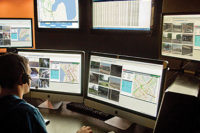Central station automation software is becoming increasingly sophisticated, often adding functionality similar to what has been pioneered in other industries.
For example, scripting capability built into new central station software prompts operators to ask the right questions in much the same way that “wizard” functionality helps people use other types of software. And the phone systems that work with some central station software are gaining automated dial-out capability akin to what people are growing increasingly accustomed to from their local school district or pharmacy.
Central station automation software is also enabling new types of monitoring such as interactive automotive monitoring. Other advances involve electronic connection to public safety answering points (PSAPs), how data is reported and depicted and more.
Dice aims to enhance efficiency
The phone system built into central station automation software from Bay City, Mich.-based DICE Corporation has gained some new capabilities aimed at enhancing central station efficiency. One key customer was able to avoid hiring extra central station operators and increase efficiency by 33 percent, observes DICE founder Cliff Dice.
One new DICE capability is to use the phone system itself to place lower-priority routine calls such as those informing customers of a low battery. Other new capabilities are on the inbound side. When a customer calls in, the system asks why the customer is calling and automatically pulls up relevant information and automatically displays it on the central station operator’s screen. The operator already has the information at the time he or she begins to speak with the customer.
“If you’re calling about service, it would pop up your past service history,” explains Dice. “If you’re calling about bill payment, it brings up your bill.”
When a company is running ads directing people to call for more information but calls can’t be answered immediately, any caller who hangs up can be called back using functionality also built into the DICE product. The person returning the call can then explain that the company has to handle emergency calls first.
The close ratio on those calls is excellent because customers are impressed that the central station called them back, observes Dice.
Micro Key gets set for ASAP-to-PSAP connection
Kissimmee, Fla.-based Micro Key Solutions is overhauling its central station operator guided response interface, explains Micro Key President Victoria Ferro. Ferro likens the move to what Apple did recently when it upgraded its iOS mobile operating system to iOS 7.
“We’re doing a similar graphic user interface update to enhance the end user experience,” explains Ferro.
Among the updates are enhanced automated action plans which walk central station operators through what to do when a specific type of signal is received. Micro Key also is adding enhanced mobile applications and enhancing dealer billing for contract central stations.
In 2014 the company also expects to have its first electronic interface to a public safety answering point (PSAP) as part of the automated secure alarm protocol (ASAP)-to-PSAP initiative. That initiative is focused on reducing the time required to dispatch responders in the event of an emergency by electronically delivering critical account information to the PSAP through a secure interface.
SGS: A map is worth a thousand words
Another central station software provider that has enhanced the scripts that operators follow when handling calls is Irvine, Calif.-based Secure Global Solutions (SGS).
Some customers have seen training time for new central station operators decrease from eight days to two days as a result of enhancements to the central station software that SGS sells under the brand name “stages,” notes Thom Meyer, vice president of research and development for SGS.
“Someone who has used Windows-based software can start contributing right away,” comments Meyer.
The action plans that the central station programs into the software can be easily customized through the use of software modules, Meyer explains. “You might have a module that says ‘Call homeowner.’ You can drop it in any of your action plans.”
SGS also recently added the ability to visualize data on a map — a capability that can simplify a range of tasks that a central station might need to handle.
For example, a company might request a map showing all accounts assigned to the Houston police department to determine which ones are incorrectly assigned. “If you have half a dozen points plotted that aren’t in Houston, those are obvious errors,” observes Meyer. “It’s more effective to show data than to list it.”
Bold Technologies enables new services
Security companies can offer new services to their customers as the result of capabilities that have been added to central station automation software from Bold Technologies of Colorado Springs, Colo.
For example the company’s BoldSOS app runs on smartphones, signaling to the central station if a customer is in an accident and the airbags in the car have deployed. Included in the signal is the user’s location, which is determined using global positioning capability.
“If the phone is still intact, it opens an audio channel to the central station using two-way voice integration,” explains Rode Coles, chief executive officer of Bold Technologies.
Customers also can use the same app when they walk through a parking lot. “If you fall, an accelerometer in the phone causes it to trigger an alarm,” comments Coles.
Other services are enabled through Bold’s Universal Connector that allows Bold’s Manitou central station software to receive what Coles calls “non-standard type signaling equipment.”
For example, he says if a device wants to send text, the Universal Connector can be configured to take a text message in and “now that text message is an alarm and can send information to Manitou.”
He notes that some customers are sending audio and video to the central station using this method.
Bold also offers security companies the ability to provide social media monitoring to their customers. This service monitors comments about a customer on social media such as Facebook and Twitter and automatically alerts the central station if a negative comment is made or if a certain threshold is reached. If this occurs, the operator responds by following instructions previously set up by the customer, which may include calling the customer.
Bold’s new SnapReporter product simplifies the way reports are created, according to Coles. The company also has added a media gateway that enables its phone system to automatically dial out to handle lower-priority calls. And a central station in Arizona is now connected electronically to a PSAP using Bold’s central station software.













